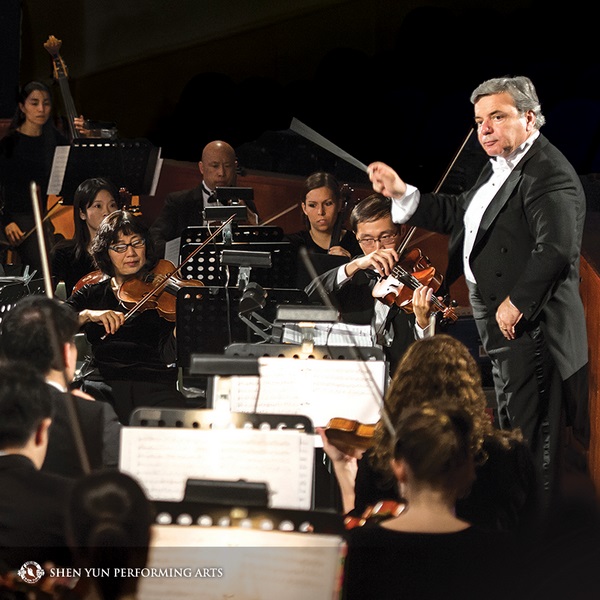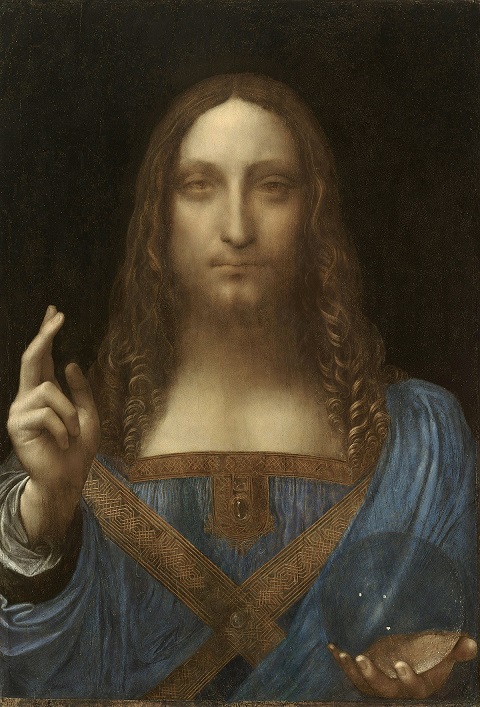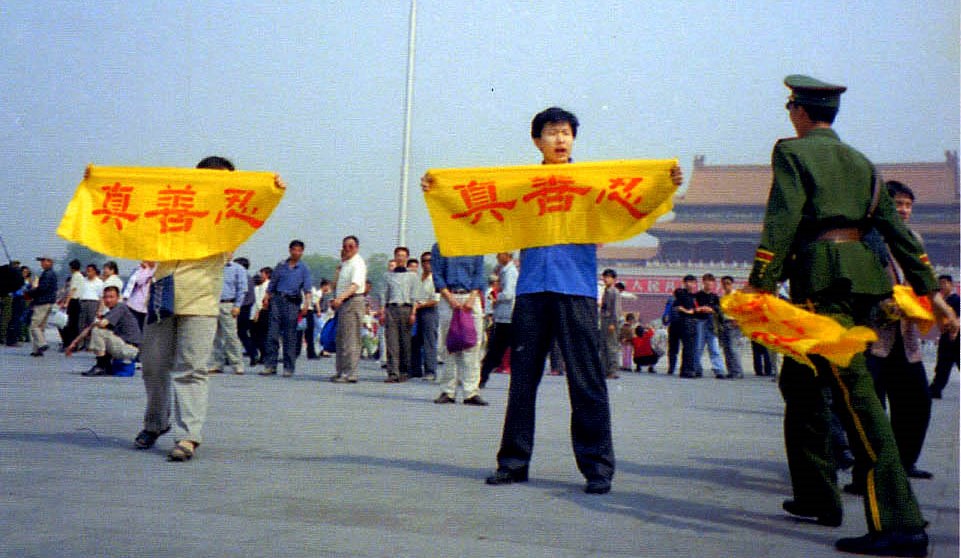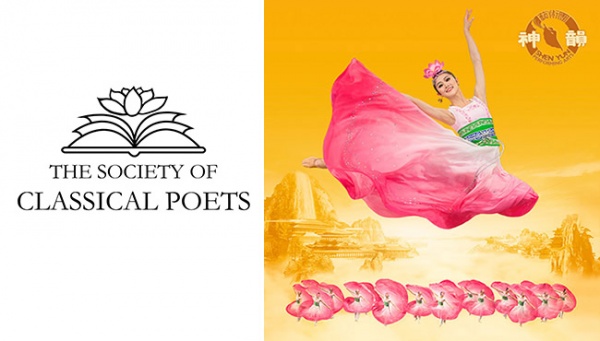Advertising for it is everywhere. If you haven’t seen it, you just haven’t been paying attention. A brilliantly colored image depicts a Chinese woman striking an airborne pose. But what is Shen Yun really all about? What does a performance involve? Whether you are a poet, an artist of any stripe, or just an interested ticket buyer, a closer look reveals an artistic vision worth exploring.
What Is Shen Yun?

As the ad suggests, dance is the centerpiece. Classical dance and folk dances from China’s many ethnicities are set to a live orchestra that combines Chinese and Western instruments. They’re augmented by an array of costumes and props and an animated backdrop that performers interact with. In more contemplative moments, a sprinkling of vocalists sing operatically in Chinese and a soloist may perform on the two-stringed erhu. The journey through a few dozen pieces is guided by two smiling hosts who both speak fluently in English and Chinese.
I have taken my family, including two small children, to see Shen Yun for the last few years. In a word, we love it. (You can read my poetry about it “I Love the Dance” and “Upon Seeing Shen Yun.”) But there is more to this story than just another individual review or a wonderful family experience.
Shen Yun was founded by a group of Chinese in New York, in 2006, who were fleeing persecution by the communist regime in China. Its backstory is not unlike that of the Renaissance, when Greek scholars fled the invading Ottoman Empire in the 15th century and ended up bringing their ancient culture to the artistically fertile shores of Italy. Now, ancient China has been reborn—and where else but in America?
What Is Classical Chinese Dance?
If there is a star to the performance, then it is classical Chinese dance. The classical school of dance we are most familiar with in the West, ballet, was developed in the grand court of French King Louis XIV less than 400 years ago. Classical Chinese dance, however, is essentially a priceless antiquity that dates back at least 3,000 years to the grand courts of Chinese emperors. Imagine ancient Greek or Egyptian statues at a museum coming to life and demonstrating for you the dance forms of their advanced cultures which have now been lost. That gives the rough idea of the vast historical value Shen Yun has harnessed.
Cynthia Paniagua, choreographer and ballet and folkloric dancer, who saw the 2018 production at Lincoln Center, in New York City, said “I absolutely loved it. I was mesmerized. As a dancer and choreographer, I was just taken away by the grace, the beauty, the culture and also the technique was just flawless… history, spirituality, it’s all there.” (All audience quotes from the Epoch Times.)
Athol Willoughby OAM, former renowned ballet dancer, who saw the 2017 Production in Melbourne, Australia, said, “I think it’s just magical. This is the fourth time I’ve seen the Shen Yun Company and I can’t believe how perfect they are. I was never going to come again because I can’t stand the fact that they’re so perfect. It makes me jealous. If only we could get that perfection in classical ballet. We try but somehow or another we just don’t get there.”
Classical Chinese dance is its own system or school of dance and contains a dazzling assortment of flips, leaps, tumbling techniques, and difficult postures—it turns out to be the origin of many of the spectacular Chinese acrobatic and gymnastic techniques you’ve probably seen elsewhere.
Also, classical Chinese dance involves an acting component that you probably haven’t seen elsewhere. It lends itself to storytelling—something like a mixture of ballet and Shakespeare: the grace and elegance of the human form on one hand, and on the other, rollicking theatrics that can be stunningly dramatic or hilariously comic.
Famous actor and comedian Tim Allen, who saw the 2017 Production in Los Angeles, said, “I get the sense of humor, it seems culture non-specific. Comedy is comedy, and I love the comedy music. I can tell right away when something is funny even though I don’t speak Chinese. It’s quite wonderful.”
Thus, about half the pieces take us into a narrative, from ancient legends of heroes and maidens to scenes from classic novels. The most poignant pieces are perhaps those depicting modern scenes where peaceful practitioners of Falun Dafa are persecuted in communist China.
Cardinal Joseph Zen Ze-kiun of the Hong Kong Catholic Church, who saw the 2017 Production in Taiwan, said, “They hold fast to the truth, but do so in a peaceful way. They hope that even those who have done wrong can ultimately understand and turn away from misdeeds. This is different from a political power struggle; they persevere because of their faith.”
A Profound Story for the Modern Era
The varied strains of the pieces all come together under a profound frame story of the Creator coming to earth to impart classical arts and culture that today are under attack. It’s an exciting story both inside the art and outside it as Shen Yun is in fact banned in China and there are detailed accounts of harassment and anti-Shen Yun campaigns carried out by Chinese consulates and overseas Chinese media around the world.
This spiritual story contains a stirring message that is resonating across languages, cultures, and age groups, earning praise from arts communities around the world—from New York’s Lincoln Center to Rome’s Teatro dell’Opera to great theaters in Japan and Taiwan. And it is a global phenomenon: Traveling to 20 countries on five continents with a new production every year, Shen Yun’s five touring companies are creating what might literally be the biggest show on Earth.
There is something universal in China’s 5,000-year-old culture, as can be seen in the commonness of Chinatowns, Chinese takeout, and martial arts in almost every corner of the developed world. Now, Shen Yun seems to be revealing a new layer of culture that people are quickly identifying as self-evidently beautiful and sublime.
Take for instance, the penetrating final words from perhaps the most famous classical work ever written in the West, the Ninth Symphony of Beethoven:
Do you sense your Creator, O world? (Ahnest du den Schöpfer, Welt?)
Seek Him above the canopy of stars! (Such’ ihn über’m Sternenzelt!)
These lyrics (written originally by German poet Friedrich Schiller) fit perfectly into Shen Yun’s theme.
As one audience member, Dr. Henry Wall, recently remarked after seeing Shen Yun’s 2018 Production in Texas, “There is a Creator, he wants you saved and go to heaven, if you’re good you go to heaven. [These] divine concepts, tradition, family—those were to me really good things for culture to have.”
Today, in a world where classical arts often struggle to survive and new and bizarre art forms are often difficult to digest, the idea of a divine culture of clear beauty made by the Creator that is now under attack, as it quite literally is by the Chinese communist regime, is perhaps the greatest story of our time.
Academy Award-winning actress Cate Blanchett said, after seeing Shen Yun in Sydney, Australia, “Exquisitely beautiful… The level of skill, but also the power of the archetypes and the narratives were startling.”
Is Shen Yun Falun Dafa Propaganda?

Despite the accusation, Shen Yun is not Falun Dafa propaganda. Just as Handel’s Messiah and da Vinci’s record-selling work “Salvator Mundi” (pictured here) are not Christian propaganda, Disney World is not Disney propaganda, and the Thor movies are not Norse mythology propaganda. Art and entertainment speak for themselves. (Although, if you go by one Merriam Webster definition, these might all be technically propaganda. I refer to the loaded, negative sense of the word.)
Falun Dafa, also known as Falun Gong, is a peaceful spiritual practice brutally persecuted by the communist regime in China. The totalitarian regime utilizes real life-destroying propaganda against Falun Dafa. According to Shen Yun, many of its performers practice Falun Dafa and many performers and their families have faced persecution in China.
Apparently, critics who make such demonizing statements fail to see the bigger story and can’t tell real propaganda, which is a crime against all of humanity, from peaceful artists expressing themselves with extraordinary bravery. It is a terrible faux pas that such critics have made. I suspect they are blinded by extreme political correctness and, ironically, a new form of bigotry. Audience members without any agenda are seeing Shen Yun for what it is.
Kieth Merrill, an Academy Award-winning documentary filmmaker, who saw Shen Yun in California, said, “In today’s world where everybody is being so politically correct and so careful about expressing your views and about being who they are and about having faith, I love it when somebody has the courage to stand out, present a big commercial presentation like this, and make it very clear who they are. They’re people of faith … and I applaud them for that.”
What is Falun Dafa?
Falun Dafa is one of China’s many privately passed on qigong or cultivation practices. It was made public in 1992 by Master Li Hongzhi. It became hugely popular until it was banned in 1999 by the Chinese Communist Party, which saw the spirituality of Falun Dafa as a threat to its officially atheist government. The human rights abuses, detailed by Freedom House, Amnesty International, and countless eyewitness accounts, are truly atrocious and a matter of urgency.

To understand the blunder of calling Shen Yun Falun Dafa propaganda more fully, one only needs to look at the name Falun Dafa itself. The first word, “Falun,” literally means “Law Wheel,” and refers to a symbol much like the swastika that has long been used in Buddhism. Even before Buddhism emerged 2,500 years ago, the symbol was widely used in ancient India and is also found among cultures around the world, from ancient Greece to the Native Americans. Before the Nazis used the swastika, it was held throughout the world to be a symbol of good luck.
The word “Dafa,” simply means “Great Way” or “Great Law”—not unlike the trendy phrase “The Tao of…” which itself means “The Way of…”—“Way” and “Law” are simply common ways of identifying a spiritual path and spiritual principles throughout cultures around the world. Thus, despite its foreign sounding name, Falun Dafa is a fitting representation of man’s spiritual aspirations.
Chinese Culture Before Communism
It is also paramount to realize that Falun Dafa in itself is representative of Chinese culture, which was always deeply spiritual before communism took hold in 1949 and actively started destroying traditional culture during the Cultural Revolution of the 1960s and 1970s.
The emperor was “The Son of Heaven,” social change was “The Mandate of Heaven,” and the founders of Chinese medicine, writing, and music were all regarded as gods on Earth. Falun Dafa’s teachings involve Buddhist and Taoist concepts that are commonly found throughout thousands of years of Chinese culture. For instance, the famous Chinese novel, Dream of the Red Chamber by Cao Xueqin, is entirely framed by a Buddhist monk and Taoist priest talking to each other and by ideas of karma, predestination, and reincarnation. The other famous Chinese novel, Journey to the West by Wu Cheng’en, takes pilgrimaging Buddhist monks as its main characters—just imagine if Prince Hamlet, Robinson Crusoe, and the Count of Monte Cristo were all Christian monks! That is the depths of the spirituality of Chinese culture before communism.
For us in the West, who grew up in school systems where teaching Darwinian evolution is mandated and teaching belief in a great and good Creator is considered scandalous, it is difficult to imagine what such a spiritual culture looks like. Shen Yun gives us an excursion into this delightfully charming and profoundly fascinating world of ancient China. Trying to fit it into a modern Westernized box is a far less rewarding exercise than simply marveling at what it can tell us about the tectonic plates shifting beneath our civilizations and cultures.
"The Society of Classical Poets" is a non-profit organization that publishes works on classical poetry, classical arts, and classical culture in general. It is the largest organization in the world dedicated to publishing classical style English-language poetry.




